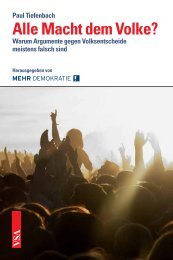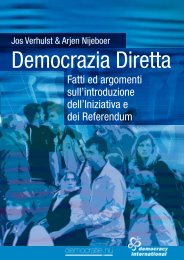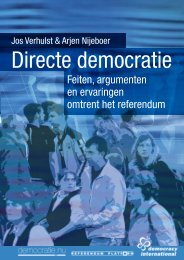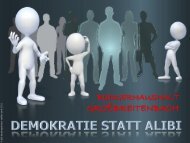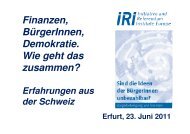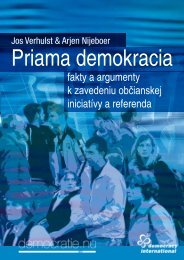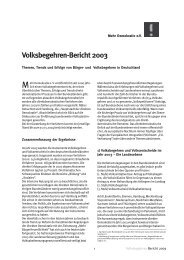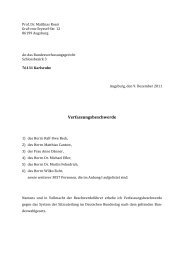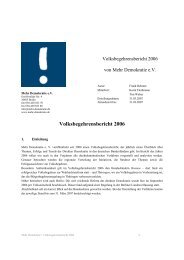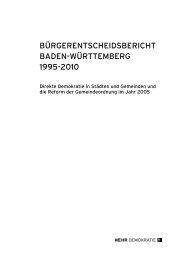Facts and Arguments about the Introduction of Initiative and ...
Facts and Arguments about the Introduction of Initiative and ...
Facts and Arguments about the Introduction of Initiative and ...
Create successful ePaper yourself
Turn your PDF publications into a flip-book with our unique Google optimized e-Paper software.
Following this criticism, <strong>the</strong> US political scientist Matsusaka,<br />
in his study ‘For <strong>the</strong> many or <strong>the</strong> few’ (2004), carefully examined<br />
<strong>the</strong> effect <strong>of</strong> <strong>the</strong> referendums on taxes <strong>and</strong> expenditure<br />
in <strong>the</strong> United States. He ga<strong>the</strong>red an enormous quantity <strong>of</strong><br />
data from all <strong>the</strong> American states <strong>and</strong> some 4,700 American<br />
cities <strong>about</strong> <strong>the</strong> last 100 years – “in essence, all <strong>the</strong> data that<br />
is currently available” (p. xi). He discovered three effects:<br />
(1) overall public expenditure by states <strong>and</strong> local councils<br />
decreased<br />
(2) expenditure is transferred to a more local level<br />
(3) <strong>the</strong>re is a shift from general taxation to payment for specific<br />
services supplied<br />
This means that <strong>the</strong> people, if <strong>the</strong>y have a chance to do so,<br />
demonstrate a tendency to slim down <strong>the</strong> state – especially<br />
<strong>the</strong> central state – <strong>and</strong> that <strong>the</strong>y are also inclined to let people<br />
pay more for <strong>the</strong>ir own consumption. In <strong>the</strong> US, <strong>the</strong> government<br />
spends approximately 36% <strong>of</strong> <strong>the</strong> GNP; <strong>about</strong> half <strong>of</strong><br />
this is spent by local councils <strong>and</strong> states. If <strong>the</strong> citizens’ initiative<br />
referendum is available in a specific state, this leads<br />
to an annual average tax reduction, for a four-person family,<br />
<strong>of</strong> $534 <strong>and</strong> to a drop <strong>of</strong> $589 in <strong>the</strong> state’s public spending.<br />
This corresponds to around 4% <strong>of</strong> <strong>the</strong> state’s income <strong>and</strong><br />
public spending. It is a significant, but not dramatic, difference<br />
in absolute terms.<br />
Matsusaka discovered ano<strong>the</strong>r remarkable finding. The arrangements<br />
for <strong>the</strong> citizens’ initiative referendum are not<br />
<strong>the</strong> same in all <strong>the</strong> states concerned. The main variable is <strong>the</strong><br />
signature threshold that must be achieved, <strong>and</strong> this can vary<br />
from 2% to 10% <strong>of</strong> <strong>the</strong> registered electorate. The impact <strong>of</strong> <strong>the</strong><br />
citizens’ initiative referendum increases systematically with<br />
<strong>the</strong> decrease in <strong>the</strong> signature threshold. In states with <strong>the</strong><br />
lowest signature thresholds, <strong>the</strong> impact <strong>of</strong> <strong>the</strong> referendum<br />
on public revenue <strong>and</strong> public spending is within a range <strong>of</strong><br />
up to 7%, whereas <strong>the</strong> impact is insignificant in states with a<br />
high threshold (p. 33-35). The easier it is to launch a citizens’<br />
initiative referendum, <strong>the</strong> lower <strong>the</strong> level <strong>of</strong> tax.<br />
The tendency to reduce taxes does not impact on all levels<br />
<strong>of</strong> public administration in <strong>the</strong> same manner. The overall<br />
reduction in tax is <strong>the</strong> result <strong>of</strong> a strong trend to reduce<br />
spending at state level by approximately 12%, combined with<br />
a less marked trend to increase spending at <strong>the</strong> local level <strong>of</strong><br />
counties <strong>and</strong> cities. This trend to decentralisation seems to<br />
be statistically very solid. This does not mean, however, that<br />
<strong>the</strong> taxes increase at local level. The higher spending in <strong>the</strong><br />
cities (to <strong>the</strong> extent that <strong>the</strong>re is a direct correlation with <strong>the</strong><br />
provisions <strong>of</strong> <strong>the</strong> popular referendum), is paid for by charges<br />
for services supplied: “At <strong>the</strong> state level <strong>the</strong> initiative led to<br />
<strong>about</strong> a 5 percent reduction in taxes <strong>and</strong> no change in charges.<br />
At <strong>the</strong> city level, <strong>the</strong> initiative led to <strong>about</strong> 14 percent more<br />
charges <strong>and</strong> no change in taxes.” (p. 52).<br />
Finally, one more remarkable finding. The data above concern<br />
<strong>the</strong> period from 1970 to 2000. Most <strong>of</strong> <strong>the</strong> states introduced<br />
<strong>the</strong> referendum around <strong>the</strong> beginning <strong>of</strong> <strong>the</strong> twentieth<br />
century <strong>and</strong> <strong>the</strong> conditions under which referendums take<br />
place have been modified very little since <strong>the</strong>n. At <strong>the</strong> start<br />
<strong>of</strong> <strong>the</strong> twentieth century, public spending was approximately<br />
6% <strong>of</strong> GNP (Gross National Product), whereas a hundred<br />
years later this figure is approaching 40%. Matsusaka also<br />
studied <strong>the</strong> effect <strong>of</strong> <strong>the</strong> referendum during <strong>the</strong> period from<br />
1902 to 1942, from which it appeared that <strong>the</strong> referendum<br />
led to an expansion <strong>of</strong> public spending. Matsusaka also found<br />
that public spending in that period increased more sharply<br />
as <strong>the</strong> signature threshold for obtaining a referendum fell.<br />
One <strong>the</strong>refore cannot unconditionally say that <strong>the</strong> referendum<br />
always leads to tax reductions. The only thing one can say is<br />
that <strong>the</strong> citizens’ initiative referendum ensures better implementation<br />
<strong>of</strong> <strong>the</strong> will <strong>of</strong> <strong>the</strong> majority. Apparently <strong>the</strong> 6% public<br />
spending around 1900 was too low in <strong>the</strong> eyes <strong>of</strong> most people<br />
(Matsusaka relates this to <strong>the</strong> rapidly increasing urbanisation<br />
at that time, which caused dem<strong>and</strong> to increase for all kinds <strong>of</strong><br />
collective infrastructure), whereas <strong>the</strong> current approximately<br />
40% is clearly considered too high <strong>and</strong> too centralised.<br />
Matsusaka devoted an extensive chapter to <strong>the</strong> question <strong>of</strong><br />
whe<strong>the</strong>r <strong>the</strong> three shifts that occurred under <strong>the</strong> influence <strong>of</strong><br />
<strong>the</strong> citizens’ initiative referendum also reflect <strong>the</strong> will <strong>of</strong> <strong>the</strong><br />
people. For this purpose he consulted <strong>the</strong> results <strong>of</strong> a large<br />
number <strong>of</strong> opinion polls that have been held during <strong>the</strong> course<br />
<strong>of</strong> <strong>the</strong> last three decades. Millions <strong>of</strong> dollars are not needed for<br />
opinion polls – a couple <strong>of</strong> thous<strong>and</strong> dollars is sufficient to<br />
hold a representative opinion poll in <strong>the</strong> US – <strong>and</strong> no campaigns<br />
costing millions are conducted. Thus <strong>the</strong>re is no distortion<br />
as a result <strong>of</strong> one-sided financing. From <strong>the</strong> opinion polls<br />
it becomes clear that most Americans are indeed supporters <strong>of</strong><br />
smaller government (which corresponds with <strong>the</strong> trend to overall<br />
tax reduction), that <strong>the</strong>y support decentralisation (spending<br />
power shifts to more local governing authorities) <strong>and</strong> that<br />
<strong>the</strong>y generally consider taxes as <strong>the</strong> least attractive source <strong>of</strong><br />
public revenue. Even more forcefully: “For every policy I am<br />
able to examine, <strong>the</strong> initiative pushes policy in <strong>the</strong> direction a<br />
majority <strong>of</strong> people say <strong>the</strong>y want to go. I am unable to find any<br />
evidence that <strong>the</strong> majority dislikes <strong>the</strong> policy changes caused<br />
by <strong>the</strong> initiative”. (Matsusaka, 2004, p. xi-xii; italicised).<br />
Matsusaka’s conclusion is clear: “Some thoughtful observers<br />
(…) have argued that <strong>the</strong> initiative allows individuals <strong>and</strong><br />
groups to bring <strong>about</strong> policies contrary to <strong>the</strong> public interest.<br />
Their argument is based on <strong>the</strong> observation that <strong>the</strong> initiative<br />
is expensive to use, <strong>and</strong> appears to be dominated by rich<br />
individuals <strong>and</strong> groups. The evidence here, however, shows<br />
that even if wealthy interests are prominent players in initiative<br />
politics, <strong>the</strong>ir efforts ultimately redound to <strong>the</strong> benefit<br />
<strong>of</strong> <strong>the</strong> majority. There is no mystery how this could happen.<br />
Without <strong>the</strong> initiative, voters are forced to accept <strong>the</strong> policy<br />
choices <strong>of</strong> <strong>the</strong> legislature. With <strong>the</strong> initiative, voters are given<br />
choices. If <strong>the</strong> alternative on an initiative is worse than <strong>the</strong><br />
legislature’s policy, <strong>the</strong> initiative can be rejected <strong>and</strong> no harm<br />
is done. If <strong>the</strong> alternative is better, <strong>the</strong> voters can accept <strong>the</strong><br />
initiative <strong>and</strong> are better <strong>of</strong>f. In short, even if <strong>the</strong>re is unequal<br />
access when it comes to proposing initiatives, <strong>the</strong> ability <strong>of</strong><br />
voters to filter out <strong>the</strong> bad proposals <strong>and</strong> keep <strong>the</strong> good ones<br />
allows <strong>the</strong> process to work to <strong>the</strong> advantage <strong>of</strong> <strong>the</strong> majority<br />
(...) I want to emphasize that <strong>the</strong> evidence is value neutral;<br />
it does not tell us whe<strong>the</strong>r <strong>the</strong> initiative process is a good or<br />
bad form <strong>of</strong> government. The evidence simply shows that <strong>the</strong><br />
initiative promotes <strong>the</strong> will <strong>of</strong> <strong>the</strong> majority” (p. 71).<br />
The role <strong>of</strong> ‘special interests’<br />
The above is closely linked to <strong>the</strong> <strong>the</strong>me <strong>of</strong> ‘special interests’.<br />
A lot <strong>of</strong> money has been involved with direct democracy in<br />
California from <strong>the</strong> beginning. In <strong>the</strong> 1922 elections, <strong>the</strong> total<br />
amount invested was already more than a million dollars. During<br />
<strong>the</strong> 1970s, ’80s <strong>and</strong> ’90s <strong>the</strong> amount <strong>of</strong> money spent on<br />
campaigns exceeded this many times over. In 1992, campaign<br />
committees in 21 states spent an estimated 117 million dollars<br />
on campaigns <strong>and</strong> in 1998 this had already risen to 400 million<br />
dollars in 44 states. Of this 400 million, California took<br />
<strong>the</strong> lion’s share with 256 million dollars spent. (Garrett <strong>and</strong><br />
Gerber, 2001, p. 73) Since <strong>the</strong> end <strong>of</strong> <strong>the</strong> 1980s, more money





